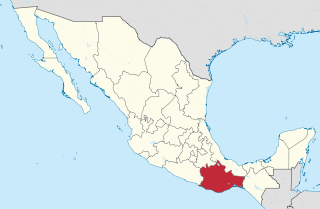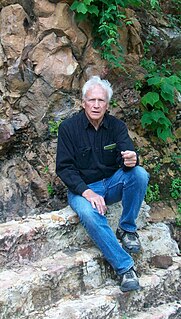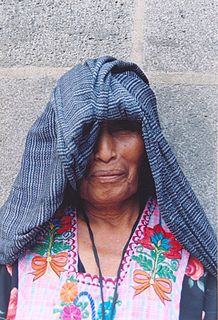Related Research Articles
The term conjunto refers to several types of small musical ensembles present in different Latin American musical traditions, mainly in Mexico and Cuba. While Mexican conjuntos play styles such as norteño and tejano, Cuban conjuntos specialize in the son, as well as its derivations such as salsa.

Oaxaca, officially the Free and Sovereign State of Oaxaca, is one of the 32 states that compose the Federative Entities of Mexico. It is divided into 570 municipalities, of which 418 are governed by the system of usos y costumbres with recognized local forms of self-governance. Its capital city is Oaxaca de Juárez.

The Mixtecs, or Mixtecos, are indigenous Mesoamerican peoples of Mexico inhabiting the region known as La Mixteca of Oaxaca and Puebla as well as the state of Guerrero's Región Montañas, and Región Costa Chica, which covers parts of the Mexican states of Oaxaca, Guerrero and Puebla.

Ana Lila Downs Sánchez is a Mexican singer-songwriter and actress. She performs her own compositions and the works of others in multiple genres, as well as tapping into Mexican traditional and popular music. She also incorporates indigenous Mexican influences and has recorded songs in many indigenous languages such as Mixtec, Zapotec, Mayan, Nahuatl and Purépecha. Born and raised in Oaxaca, she primarily studied at the Institute of Arts by Oaxaca and briefly attended University of Minnesota, before withdrawing to focus on her musical career. She soon began performing in the traditional music scene of Oaxaca City.

Norteño or Norteña, also música norteña, is a genre of Regional Mexican music from Northern Mexico, hence the name. The music is most often based on duple and triple metre and its lyrics often deal with socially relevant topics, although there are also many norteño love songs. The accordion and the bajo sexto are traditional norteño's most characteristic instruments. Norteña music developed in the late 19th century, as a mixture between local Mexican music and German/Austrian/Czech folk music.

Bajo sexto is a Mexican string instrument from the guitar family with 12 strings in six double courses. A closely related instrument is the bajo quinto which has 10 strings in five double courses.
Regional styles of Mexican music vary greatly vary from state to state. Norteño, banda, duranguense, Son mexicano and other Mexican country music genres are often known as regional Mexican music because each state produces different musical sounds and lyrics.

Heroica Ciudad de Huajuapan de León[waˈxwapan de leˈon] is a city with a surrounding municipality located in the northwestern part of the Mexican state of Oaxaca. It is part of the Huajuapan District in the north of the Mixteca Region. It has a population of about 45,321, the sixth-largest community in the state in population. It is located at the intersection of Federal Highways 125 and 190. The name of Huajuapan comes from the Nahuatl words huaxin = huaje, ohtli = road, and apan = river. Literally, River of the huajes. The town was elevated to an honorary Mexican status in June 1843 in remembrance of The siege of Huajuapan, a battle between the royal army and the insurgents led by José María Morelos. The battle was won by the insurgents. The city was named after Antonio de León, a hero of the Mexican War of Independence.

Pelota mixteca is a team sport similar to a net-less tennis game. The players wear sturdy, elaborately decorated gloves affixed to a heavy flat striking surface, using them to strike a small solid ball. The game has roots extending back hundreds, or perhaps thousands, of years.

Ronald M. Spores is an American academic anthropologist, archaeologist and ethnohistorian, whose research career has centered on the pre-Columbian cultures of Mesoamerica. He is Professor Emeritus of anthropology at Vanderbilt University's College of Arts and Science, where he has been a faculty member for over four decades. Spores is most renowned for his scholarship conducted on the cultural history of the Oaxacan region in southwestern Mexico. In particular, he has made many contributions on the Mixtec culture, investigating its archaeological sites, ethnohistorical documents, political economies, and ethnohistory in both the pre-Columbian and Colonial eras. He was Co-Director of the Proyecto Arqueológico de la Ciudad Yucundaa Pueblo Viejo de Teposcolula, Oaxaca, sponsored by the Fundación Alfredo Harp Helu, the National Geographic Society, and INAH (2004–2010), and currently (2017) directs research on the sixteenth century Casa del Cacique de Yanhuitlan, Oaxaca, and related investigation of the surrounding Prehispanic-Colonial city and region. He is also Research Associate at the American Museum of Natural History, New York, and at the University of Oregon and investigator on the Proyecto Geoparque de la Mixteca Alta, Universidad Nacional Autónoma de México/UNESCO, centered at Yanhuitlan, Oaxaca (2016-2017). Recent research relates to the colonial Manila Galleon trade between the Philippines and Acapulco.

San Juan Achiutla is a town and municipality in Oaxaca in south-western Mexico. The municipality covers an area of 49.76 km2. It is located in a mountain range, between the hills Negro to the East, Yucuquise to the Northwest, Cuate to the North and Totolote to the South. It is crossed by the river Los Sabinos and has a dam called Cahuayande. Its weather is temperate. It is in the Mixteca Alta, one of the three parties that make up the Mixteca region and in the Mixteca Alta is part of what was Achiutla, the significant Prehispanic place.

San Martín Peras is a town and municipality in Oaxaca about 157 mi south of Mexico City which is the country's capital city. The municipality covers an area of 237.31km2 and is part of the Juxtlahuaca district of the Mixteca Region. The local time zone is named "America/Mexico City" with a UTC offset of -6 hours.
Enrico Chapela is a Mexican contemporary classical composer, whose works have been played by multiple major orchestras and has been commissioned to compose for institutions such as the Los Angeles Philharmonic, the National Center for the Performing Arts (Beijing) and the Festival Internacional Cervantino. His work is influenced by modern popular musical styles such as rock and electronic, as well as Mexican popular culture.

The Indigenous people of Oaxaca are descendants of the inhabitants of what is now the state of Oaxaca, Mexico who were present before the Spanish invasion. Several cultures flourished in the ancient region of Oaxaca from as far back as 2000 BC, of whom the Zapotecs and Mixtecs were perhaps the most advanced, with complex social organization and sophisticated arts.

The state of Oaxaca, Mexico has a total population of about 3.5 million, with women outnumbering men by 150,000 and about 60% of the population under the age of 30. It is ranked tenth in population in the country. Fifty three percent of the population lives in rural areas. Most of the state’s population growth took place between 1980 and 1990. Life expectancy is 71.7 for men and 77.4 for women, just under the national average. Births far outpace deaths. In 2007, there were 122,579 birth and 19,439 deaths. Approximately 85% profess the Catholic faith.
Mixteca Alta Formative Project (2003–present) is an archaeological project directed by Andrew Balkansky that focuses on the Mixtec of Oaxaca, Mexico. The project, which is funded by the National Science Foundation, the National Geographic Society, and the H. John Heinz III Fund, seeks to understand Mixtec origins and their transition to urbanism. Excavations are currently taking place at the ancient site of Tayata.
Ofrenda is the debut album by Mexican singer-songwriter Lila Downs. It was released in 1994, the songs are a collection of traditional songs from Oaxaca, Mexico, and also contains songs written by the singer. The songs on this album are sung in Spanish, Mixtec and Zapotec, the latter two being languages native to the State of Oaxaca. Lila Downs recorded this LP independently with the support of Oaxacan Institute of Cultures in 1992 and 1994.
Indigenous Mexican Americans or Mexican American Indians are American citizens who are descended from the indigenous peoples of Mexico. Indigenous Mexican-Americans usually speak an Indigenous language as their first language and may not speak either Spanish or English. Indigenous Mexican-Americans may or may not identify as "Hispanic" or "Latino".
Paso del Norte is a modern opera composed by Mexican Víctor Rasgado. The work is based on a play, which in turn is based on the real story of a group of migrants who become trapped in a train car on their way to the United States, with all but one succumbing to suffocation. The orchestration of the work is notable as it is a mix of modern symphony and traditional village band music. For the work’s premiere in the city of Oaxaca, the music was reorchestrated so that it could be played by a real village band, one from the small Oaxacan town of San Bartolomé Zoogocho. Since then, the work has been performed multiple times in Mexico City and Ciudad Juarez, as well as the 2014 Festival Internacional Cervantino.
Juana Coralia López Valdés was a Cuban pianist, bandleader and composer. Between 1940 and 1956 she directed her own charanga danzonera, being the first woman to direct any such orchestra in Cuba. During her career she composed many popular danzones such as "Llegó Manolo", "El bajo que come chivo", "Los jóvenes del agua fria" and the famous "Isora Club", which became a standard in the Latin music repertoire.
References
- 1 2 3 4 Victoria Infante (October 7, 2012). "Pasatono recupera y resguarda la música tradicional de la mixteca oaxaqueña". The Huffington Post. Retrieved May 23, 2015.CS1 maint: discouraged parameter (link)
- 1 2 3 Feliz Contreras (May 11, 2014). "First Listen: Pasatono Orquesta, 'Maroma'". Washington, DC: NPR. Retrieved May 23, 2015.CS1 maint: discouraged parameter (link)
- 1 2 3 4 5 6 Catalina Maria Johnson (December 18, 2014). "Beat Latino: La fiesta musical mixteca". Mexico City: Vive Lo Hoy. Archived from the original on September 27, 2015. Retrieved May 23, 2015.CS1 maint: discouraged parameter (link)
- 1 2 3 4 5 6 7 8 9 10 "Pasatono Orquesta revalora el circo y la música de la Mixteca". Mexico: Government of Oaxaca. Retrieved May 23, 2015.CS1 maint: discouraged parameter (link)
- 1 2 3 4 5 "Biografía" . Retrieved May 23, 2015.CS1 maint: discouraged parameter (link)
- 1 2 "Pasatono Orquesta". The Kennedy Center. Archived from the original on February 3, 2013. Retrieved May 23, 2015.CS1 maint: discouraged parameter (link)
- 1 2 3 "Getty's Sounds of L.A. Welcomes Oaxaca-Based Pasatono Orquesta". The J. Paul Getty Trust. Archived from the original on October 6, 2015. Retrieved May 23, 2015.CS1 maint: discouraged parameter (link)
- 1 2 3 4 5 Andrew Gilbert (December 12, 2014). "Sounds of Oaxaca: Pasatono Orquesta play Berkeley". Berkeley, CA: Berkeleyside. Retrieved May 23, 2015.CS1 maint: discouraged parameter (link)
- 1 2 3 Betto Arcos (June 26, 2014). "The circus music of Oaxaca's Pasatono Orquesta is magical". Minneapolis: PRI's The World. Retrieved May 23, 2015.CS1 maint: discouraged parameter (link)
- 1 2 3 Aarik Danielsen (May 18, 2014). "Waking up to wonderful sounds". New York: Colombia Tribune. Retrieved May 23, 2015.CS1 maint: discouraged parameter (link)
- 1 2 3 4 Nidia Rosales Moreno. "Pasatono: música de la mixteca oaxaqueña". Mexicoi: CONACULTA. Archived from the original on October 26, 2014. Retrieved May 23, 2015.CS1 maint: discouraged parameter (link)